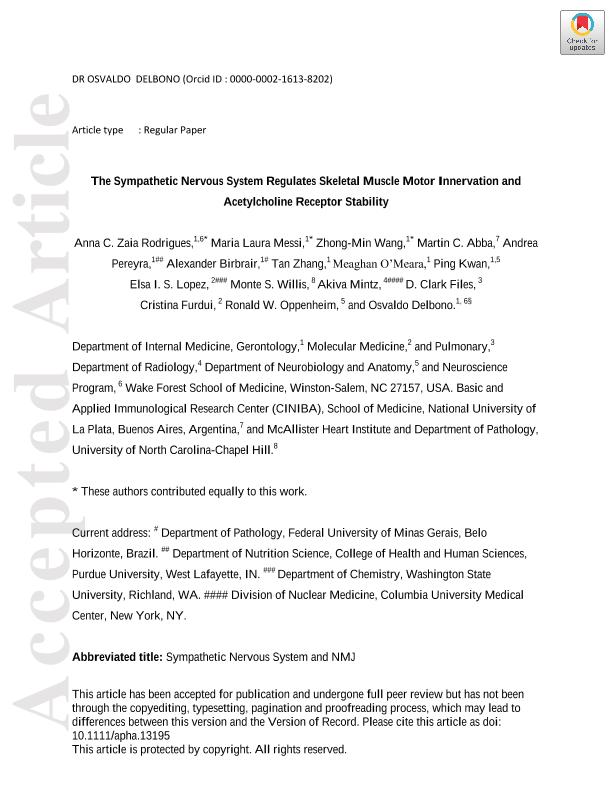Mostrar el registro sencillo del ítem
dc.contributor.author
Rodrigues, Anna C. Zaia
dc.contributor.author
Messi, Maria Laura
dc.contributor.author
Wang, Zhong Min
dc.contributor.author
Abba, Martín Carlos

dc.contributor.author
Pereyra, Andrea Soledad

dc.contributor.author
Birbrair, Alexander
dc.contributor.author
Zhang, Tan
dc.contributor.author
O´Meara, Meaghan
dc.contributor.author
Kwan, Ping
dc.contributor.author
Lopez, Elsa I. S.
dc.contributor.author
Willis, Monte S.
dc.contributor.author
Mintz, Akiva
dc.contributor.author
Files, D. Clark
dc.contributor.author
Furdui, Cristina
dc.contributor.author
Oppenheim, Ronald W.
dc.contributor.author
Delbono, Osvaldo

dc.date.available
2020-11-09T16:53:28Z
dc.date.issued
2019-03
dc.identifier.citation
Rodrigues, Anna C. Zaia; Messi, Maria Laura; Wang, Zhong Min; Abba, Martín Carlos; Pereyra, Andrea Soledad; et al.; The sympathetic nervous system regulates skeletal muscle motor innervation and acetylcholine receptor stability; Wiley Blackwell Publishing, Inc; Acta Physiologica; 225; 3; 3-2019; 1-78
dc.identifier.issn
1748-1708
dc.identifier.uri
http://hdl.handle.net/11336/117935
dc.description.abstract
Aim: Symptoms of autonomic failure are frequently the presentation of advanced age and neurodegenerative diseases that impair adaptation to common physiologic stressors. The aim of this work was to examine the interaction between the sympathetic and motor nervous system, the involvement of the sympathetic nervous system (SNS) in neuromuscular junction (NMJ) presynaptic motor function, the stability of postsynaptic molecular organization, and the skeletal muscle composition and function. Methods: Since muscle weakness is a symptom of diseases characterized by autonomic dysfunction, we studied the impact of regional sympathetic ablation on muscle motor innervation by using transcriptome analysis, retrograde tracing of the sympathetic outflow to the skeletal muscle, confocal and electron microscopy, NMJ transmission by electrophysiological methods, protein analysis, and state of the art microsurgical techniques, in C57BL6, MuRF1KO and Thy-1 mice. Results: We found that the SNS regulates motor nerve synaptic vesicle release, skeletal muscle transcriptome, muscle force generated by motor nerve activity, axonal neurofilament phosphorylation, myelin thickness, and myofibre subtype composition and CSA. The SNS also modulates the levels of postsynaptic membrane acetylcholine receptor by regulating the Gα i2 -Hdac4-Myogenin-MuRF1pathway, which is prevented by the overexpression of the guanine nucleotide-binding protein Gα i2 (Q205L), a constitutively active mutant G protein subunit. Conclusion: The SNS regulates NMJ transmission, maintains optimal Gα i2 expression, and prevents any increase in Hdac4, myogenin, MuRF1, and miR-206. SNS ablation leads to upregulation of MuRF1, muscle atrophy, and downregulation of postsynaptic AChR. Our findings are relevant to clinical conditions characterized by progressive decline of sympathetic innervation, such as neurodegenerative diseases and aging.
dc.format
application/pdf
dc.language.iso
eng
dc.publisher
Wiley Blackwell Publishing, Inc

dc.rights
info:eu-repo/semantics/openAccess
dc.rights.uri
https://creativecommons.org/licenses/by-nc-sa/2.5/ar/
dc.subject
MUSCLE DENERVATION
dc.subject
MUSCLE INNERVATION
dc.subject
NEUROMUSCULAR JUNCTION
dc.subject
SKELETAL MUSCLE
dc.subject
SYMPATHETIC NERVOUS SYSTEM
dc.subject.classification
Bioquímica y Biología Molecular

dc.subject.classification
Ciencias Biológicas

dc.subject.classification
CIENCIAS NATURALES Y EXACTAS

dc.title
The sympathetic nervous system regulates skeletal muscle motor innervation and acetylcholine receptor stability
dc.type
info:eu-repo/semantics/article
dc.type
info:ar-repo/semantics/artículo
dc.type
info:eu-repo/semantics/publishedVersion
dc.date.updated
2020-11-05T15:37:23Z
dc.journal.volume
225
dc.journal.number
3
dc.journal.pagination
1-78
dc.journal.pais
Reino Unido

dc.journal.ciudad
Londres
dc.description.fil
Fil: Rodrigues, Anna C. Zaia. Wake Forest School of Medicine; Estados Unidos
dc.description.fil
Fil: Messi, Maria Laura. Wake Forest School of Medicine; Estados Unidos
dc.description.fil
Fil: Wang, Zhong Min. Wake Forest School of Medicine; Estados Unidos
dc.description.fil
Fil: Abba, Martín Carlos. Consejo Nacional de Investigaciones Científicas y Técnicas. Centro Científico Tecnológico Conicet - La Plata; Argentina. Universidad Nacional de La Plata. Facultad de Ciencias Médicas. Centro de Investigaciones Inmunológicas Básicas y Aplicadas; Argentina
dc.description.fil
Fil: Pereyra, Andrea Soledad. Consejo Nacional de Investigaciones Científicas y Técnicas. Centro Científico Tecnológico Conicet - La Plata; Argentina. Wake Forest School of Medicine; Estados Unidos
dc.description.fil
Fil: Birbrair, Alexander. Wake Forest School of Medicine; Estados Unidos
dc.description.fil
Fil: Zhang, Tan. Wake Forest School of Medicine; Estados Unidos
dc.description.fil
Fil: O´Meara, Meaghan. Wake Forest School of Medicine; Estados Unidos
dc.description.fil
Fil: Kwan, Ping. Wake Forest School of Medicine; Estados Unidos
dc.description.fil
Fil: Lopez, Elsa I. S.. Wake Forest School of Medicine; Estados Unidos
dc.description.fil
Fil: Willis, Monte S.. University of North Carolina; Estados Unidos
dc.description.fil
Fil: Mintz, Akiva. Wake Forest School of Medicine; Estados Unidos
dc.description.fil
Fil: Files, D. Clark. University of North Carolina; Estados Unidos
dc.description.fil
Fil: Furdui, Cristina. Wake Forest School of Medicine; Estados Unidos
dc.description.fil
Fil: Oppenheim, Ronald W.. Wake Forest School of Medicine; Estados Unidos
dc.description.fil
Fil: Delbono, Osvaldo. Wake Forest School of Medicine; Estados Unidos
dc.journal.title
Acta Physiologica

dc.relation.alternativeid
info:eu-repo/semantics/altIdentifier/url/https://onlinelibrary.wiley.com/doi/abs/10.1111/apha.13195
dc.relation.alternativeid
info:eu-repo/semantics/altIdentifier/doi/https://doi.org/10.1111/apha.13195
Archivos asociados
